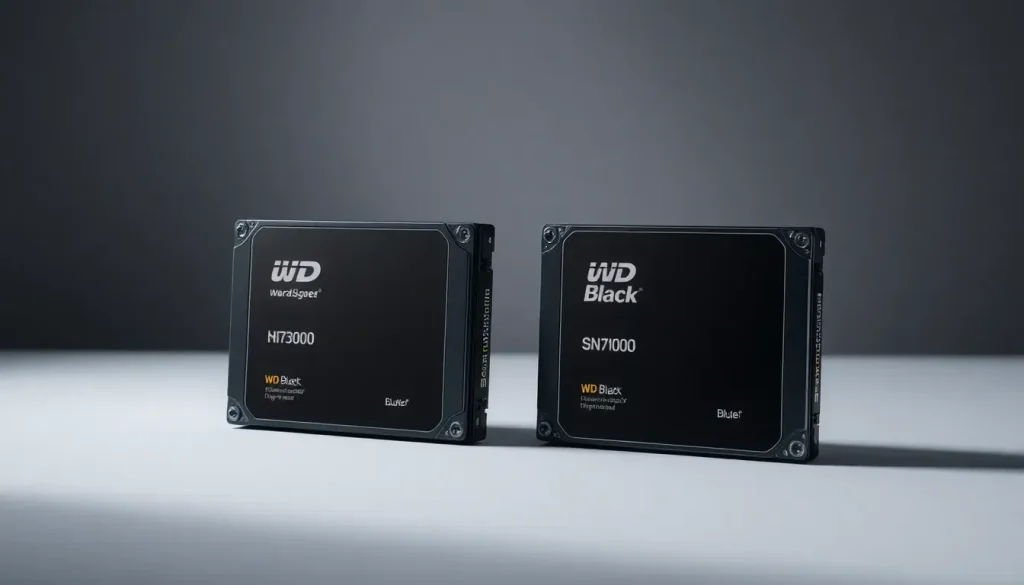WD Blue SN5000 compared to WD Black SN7100 performance

When it comes to choosing the right SSD for your system, understanding the differences between models can make a significant impact on your overall experience. The WD Blue SN5000 and WD Black SN7100 are two contenders in the Gen 4.0 mid-range segment that cater to different user needs. With various features and performance metrics to consider, let's dive deeper into what makes each of these drives unique and which one might be the best fit for your specific requirements.
Both SSDs are designed to provide reliable performance while balancing cost and efficiency. However, they cater to different user bases—ranging from casual users to gamers and professionals seeking top-tier performance.
Comparing theoretical specifications
The WD Black SN7100 clearly outperforms the WD Blue SN5000 in several theoretical metrics. It utilizes the latest BiCS8 NAND technology, boasting 218 layers compared to the 112 layers of BiCS5 in the Blue variant. This difference translates into a noticeable performance enhancement:
- Sequential Read Speeds: The SN7100 achieves sequential read speeds exceeding 7,000 MB/s, whereas the SN5000 hovers around 5,000 MB/s.
- Sequential Write Speeds: The write speeds of the SN7100 can surpass those of the SN5000 by nearly 2,000 MB/s at certain capacities.
- Random IOPS Performance: The SN7100 exhibits superior random input/output operations per second (IOPS), making it better suited for heavy workloads.
In summary, the WD Black SN7100 caters to gamers, content creators, and professionals who prioritize performance, while the WD Blue SN5000 serves well for everyday tasks without the added cost of high-end features.
Benchmark scores compared
Benchmarking provides insight into how these drives perform under various conditions. Below, we summarize the performance of the SN5000 and SN7100 across different tests.
PCMark 10 Full Drive Benchmark
This benchmark evaluates a drive's capability as the primary OS drive, simulating real-world tasks like editing documents and loading applications.
- The SN7100 (2TB) scores approximately 15% higher than the SN5000, showcasing significantly improved performance.
- It also demonstrates better bandwidth and lower latency, making it ideal for speed-focused tasks.
3DMark Storage Test for Gamers
Tailored for gaming scenarios, this test assesses loading times and performance in gaming environments.
- The SN5000 (4TB) fared slightly better with a score of 4214 compared to the SN7100's 4068.
- Despite the SN5000's edge, the SN7100 maintains competitive performance, especially in multitasking contexts.
CrystalDiskMark Sequential Read/Write Performance
In this test, the SN7100 excels at higher queue depths, showing its capability for sustained data transfers.
- At QD8, the SN7100 significantly outpaces the SN5000 in both read and write speeds.
- Even in single-queue depth, the SN7100 demonstrates superior write capabilities.
CrystalDiskMark Random Read/Write Performance
Here, we evaluate the performance using small data blocks, simulating everyday usage scenarios.
- The SN7100 outshines the SN5000 in random read/write tests, particularly in high-queue scenarios.
- This makes the SN7100 a better option for tasks requiring heavy multitasking.
File Transfer Rate
In file transfer tasks, the SN7100 consistently outperforms the SN5000, especially when dealing with large files.
- Its ability to read compressed files faster indicates stronger sustained performance.
- The SN5000, while reliable, does not match the speed of the SN7100 for frequent file transfers.
Power consumption and efficiency
Efficiency is crucial for long-term use, especially in portable systems. The SN5000 demonstrates a higher throughput per watt, making it the more efficient option overall.
- It features a slightly lower idle power draw, which may appeal to energy-conscious users.
- The SN7100, while competitive, consumes more power at idle but excels during peak usage.
Durability metrics: TBW, DWPD, MTBF, and warranty
Durability is a key factor when selecting an SSD. The SN7100 offers a higher Total Bytes Written (TBW) rating for its 2TB and 4TB variants, while the 500GB and 1TB versions share the same TBW rating. It's important to note:
- The Drive Writes Per Day (DWPD) rating remains consistent at 0.3 for all versions, except for the 2TB and 4TB SN5000, which have a DWPD of 0.2.
- These metrics are critical for users who plan to put their SSDs through heavy data-writing tasks.
Technical specifications overview
The technical specifications further highlight the differences between the two models:
- The SN7100 benefits from higher raw NAND speed, which translates into better performance in demanding applications.
- While both models have a Pseudo-SLC write cache, the SN7100 features a dynamic cache of around 650GB for its 4TB variant.
- Notably, the SN7100 lacks encryption, which can be a concern for users prioritizing data security.
Price comparison
Price can be a decisive factor when selecting an SSD. The differences in cost between the SN5000 and SN7100 are minimal for the 500GB and 1TB variants:
- The SN7100 is typically $1 to $2 more expensive for these lower-capacity variants.
- As capacities increase, the price difference becomes more pronounced. For instance, the 2TB SN5000 retails at approximately $124.99, while the SN7100 is available for $149.99, a $25 difference.
- It's advisable to check various retailers to ensure you get the best deal.
Additional considerations for choosing your SSD
When deciding between the WD Blue SN5000 and WD Black SN7100, consider additional factors that may influence your choice:
- Use Case: Identify whether you need the SSD for casual usage, gaming, or professional work.
- Capacity Needs: Assess how much storage you require based on your typical workloads.
- Future-Proofing: If upcoming workloads demand higher speeds, investing in a more robust SSD like the SN7100 could be beneficial.
- Budget Constraints: Determine how much you're willing to spend while balancing performance needs.
For a visual comparison of performance metrics, you may find this video insightful:




Leave a Reply